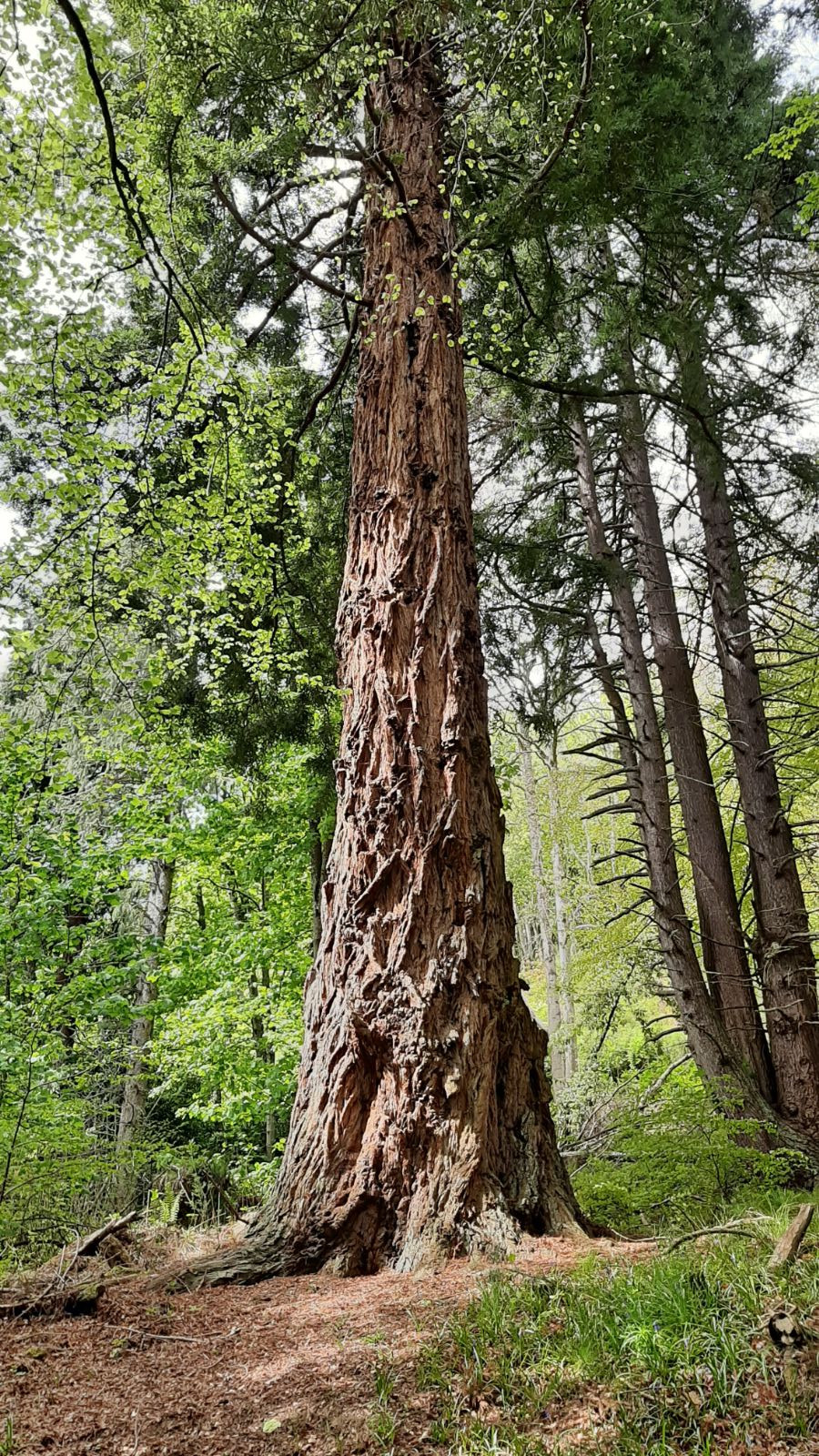Sequoia
Sponsor
Kindly sponsored by
a member of the International Dendrology Society
Credits
Tom Christian (2024)
Recommended citation
Christian, T. (2024), 'Sequoia' from the website Trees and Shrubs Online (treesandshrubsonline.
Family
- Cupressaceae
Synonyms
- Codylocarpus Salisb. ex Lamb.
- Gigantabies J.Nelson
A monospecific genus closely allied to Sequoiadendron, differing from it in its branches with defined regions of annual growth, leaves mostly arranged in 2 ranks, linear, flattened, needle-like, the seed cones 1.3–3.5 cm long (cf. branches without defined regions of annual growth, leaves spirally arranged, triangular in cross-section, scale- or awl-like, the seed cones 4–10 cm long) (Watson & Eckenwalder 1993). For a full description see Sequoia sempervirens.
When Endlicher named Sequoia in 1847 he did not leave any clues to its etymology. It was soon assumed, and passed into conventional wisdom, that he named the genus in honour of Sequoiah (alias George Guess, d. 1843), the son of a British trader and a Cherokee woman. Sequoiah ‘devised an alphabet for the Cherokee tongue, thanks to which the tribe quickly became literate and even had a newspaper in their own language’ (Bean 1981). Bean would go on to note that ‘neither [Sequoiah], nor his tribe, ever lived within the area of the redwoods’ but Endlicher was a philologist and may have known of Sequoiah’s work (Earle 2024).
For some time, though, an alternative theory has been favoured in some quarters – particularly in academic circles – that Endlicher’s Sequoia is actually derived from the latin ‘to follow’ or ‘to succeed’, either because, at the time, the species was considered the sole living descendent of a large group of mostly extinct trees, or else because of a character that would have been of significant interest to Endlicher himself. In the 1840s Endlicher was working on a classification of conifers that focussed on a sequence of cone scale relationships, but there was a gap in his sequence until he was able to examine specimens of Sequoia, at which point his sequence was complete and so he derived the new generic name from this event (Lowe 2012). The epithet sempervirens, meaning ‘always green’, was used in David Don’s basionym (the first name applied to a plant) of 1824, when the species was thought to belong to the related genus Taxodium, hitherto known as a genus of deciduous conifers hence the logic in singling out the evergreen one with the epithet sempervirens. Following the rules of botanical nomenclature, when Endlicher described the new genus Sequoia, the epithet sempervirens remained in use in a new combination.
For many years Sequoia was placed in the now-defunct family Taxodiaceae, along with Athrotaxis, Cryptomeria, Cunninghamia, Glyptostrobus, Metasequoia, Sequoiadendron, Taiwania and Taxodium (Debreczy & Rácz 2011). (The Japanese endemic Sciadopitys was occasionally included here, though never comfortably, and has long been recognised as belonging to its own family, Sciadopityaceae.) The Taxodiaceae was defined by the spirally-arranged, needle-like leaves, and the basal placement of the ovules on the cone bracts. When Metasequoia was discovered in the 1940s, with opposite leaves but otherwise strongly resembling Sequoia and Sequoiadendron in cone features, the aberrance highlighted others that had hitherto been tolerated, such as the presence of reduced, scale-like leaves in Athrotaxis and Sequoiadendron (Farjon 2017). In a detailed study, Eckenwalder (1976) demonstrated that no member of Taxodiaceae could justifiably be separated from Cupressaceae; later phylogenetic studies supported Eckenwalder’s view and Taxodiaceae was merged into Cupressaceae.
Whilst the parameters of Cupressaceae (sensu lato) are now well established, the relationships between genera (and indeed the delimitation of genera like Cupressus and Juniperus) are far from settled (Debreczy & Rácz 2011). As Farjon observes, the genera of the old Taxodiaceae do not form a coherent clade within Cupressaceae, but represent a ‘grade’ of taxa with less advanced character states compared with e.g. Juniperus. The old Taxodiaceae are predominantly monospecific, often with other species known from the fossil record, and ‘therefore constitute a loose assembly of relict species with more or less basal positions in the phylogeny of the Cupressaceae’ (Farjon 2017). One of the most recent gymnosperm classifications supports this, placing Sequoia, Sequoiadendron and Metasequoia together in the tribe Sequoioideae; Cryptomeria, Glyptostrobus and Taxodium together in Taxodioideae; while the remaining genera all sit in their own unique tribes, viz. Athrotaxioideae, Cunninghamioideae, and Taiwanioideae (Yang et al. 2022).
This seems unlikely to be the final word on the matter, however. In 2017, the Save the Redwoods League announced a project to sequence the genomes of Sequoia sempervirens and Sequoiadendron giganteum. The completion of these ground-breaking projects was announced in 2021, and the data made available to the scientific community (Save the Redwoods League 2021). Sequoia had long been acknowledged as the only hexaploid conifer and for many years the prevailing hypothesis was that this was the result of ancient hybridisation, probably dating to the Cretaceous (e.g. Earle 2024). The results of the Save the Redwoods League studies, however, show that Sequoia’s hexaploidy is the result of autopolyploidy (i.e. a single ancestral species) and not due to hybridisation (Neale et al. 2022).

